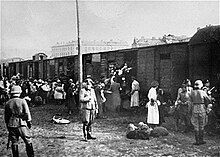
Ostbahn (German: for Eastern Railway) in the General Government, were the Nazi German railways in occupied Poland during World War II, subordinated to the General Directorate of Eastern Railways (German: Generaldirektion der Ostbahn, Gedob) in occupied Kraków; a branch of the Deutsche Reichsbahn National Railway of Germany in the newly created Generalgouvernement territory under Hans Frank. The trains were used to cleanse and resettle interwar Poland with the German-speaking colonists in the name of "Lebensraum", and played an essential role in the mass deportations of Jews to extermination camps during the Holocaust.
History

Following invasion of Poland in September 1939 Nazi Germany disbanded Polish National Railways (PKP) immediately, and handed over their assets to the Deutsche Reichsbahn in Silesia, Greater Poland and in Pomerania. In November 1939, as soon as the semi-colonial General Government was set up in occupied central Poland, a separate branch of DRB called Generaldirektion der Ostbahn (Kolej Wschodnia in Polish) was established with headquarters called GEDOB in Kraków; all of the DRB branches existed outside Germany proper. The Ostbahn was granted 3,818 kilometres (2,372 mi) of railway lines (nearly doubled by 1941) and 505 km of narrow gauge, initially.
In December 1939, on the request of Hans Frank in Berlin, the Ostbahndirektion was given financial independence after paying back 10 million Reichsmarks to DRB. The removal of all bomb damage was completed in 1940. The Polish management was either executed in mass shooting actions (see: the 1939 Intelligenzaktion and the 1940 German AB-Aktion in Poland) or imprisoned at the Nazi concentration camps. Managerial jobs were staffed with German officials in a wave of some 8,000 instant promotions. The new Eastern Division of DRB acquired 7,192 kilometres (4,469 mi) of new railway lines and 1,052 km of (mostly industrial) narrow gauge in the annexed areas.
Notes
- Bochen, Antoni; Wiśniewski, Filip (2018). "Occupation 1939-1945". Polish Railways. Quixi Media. Archived from the original on 2020-07-21. Retrieved 2018-04-14.
- ^ Gigliotti, Simone (2009). The Train Journey: Transit, Captivity, and Witnessing in the Holocaust. Berghahn Books. ISBN 978-1845459277.
- Berghahn, Volker R. (1999). "Germans and Poles 1871–1945". In Bullivant, Keith; Giles, Geoffrey J.; Pape, Walter (eds.). Germany and Eastern Europe: Cultural Identities and Cultural Differences. Rodopi. pp. 32–34. ISBN 9042006889.; and Blanke, Richard (1999). "When Germans and Poles Lived Together". In Bullivant, Keith; Giles, Geoffrey J.; Pape, Walter (eds.). Germany and Eastern Europe: Cultural Identities and Cultural Differences. Rodopi. pp. 50ff. ISBN 9042006889.
- ^ Wasilewski, Jerzy (2014). "25 September: Absorption of Polish Railways by the German Reichsbahn" [25 września. Wcielenie kolei polskich na Śląsku, w Wielkopolsce i na Pomorzu do niemieckich kolei państwowych Deutsche Reichsbahn]. Polskie Koleje Państwowe PKP. Historia kolei na terenie Polski. Archived from the original on 2014-02-08 – via Archive.is, page missing from Wayback, 8 February 2014.
- Gigliotti, Simone (2009). "Resettlement". The Train Journey: Transit, Captivity, and Witnessing in the Holocaust. Berghahn Books. pp. 55–. ISBN 978-1845459277. Retrieved 21 September 2015.
- ^ Masłowska, Teresa (2 September 2007). "Wojenne Drogi Polskich Kolejarzy" [On the war paths of Polish railwaymen] (PDF). Kurier PKP. 35. Września: 13. Archived from the original (PDF) on 24 February 2012. Retrieved 8 February 2014 – via PDF file, direct download (644 KB), archived by Wayback Machine. Magazine Kurier PKP was last published in 2010.
- Mierzejewski, Alfred C. (2003). Most Valuable Asset of the Reich: A History of the German National Railway. Vol. 2: 1933-1945. Univ. of North Carolina Press. pp. 78–80. ISBN 9780807825747.
- Pottgiesser, Hans (1975) . Die Deutsche Reichsbahn im Ostfeldzug 1939 - 1944. Kurt Vowinkel Verlag. pp. 17–18.
External links
- Photo of Governor Hans Frank (left) handing over the Ostbahn leadership to Adolf Gerteis. Also present: Josef Friedrich Buhler (in the background, first on the left) and Arthur Seyss-Inquart (on the right). April 1940, Kraków, Zakład fotograficzny Otto Rosner. Zbiory NAC on-line.